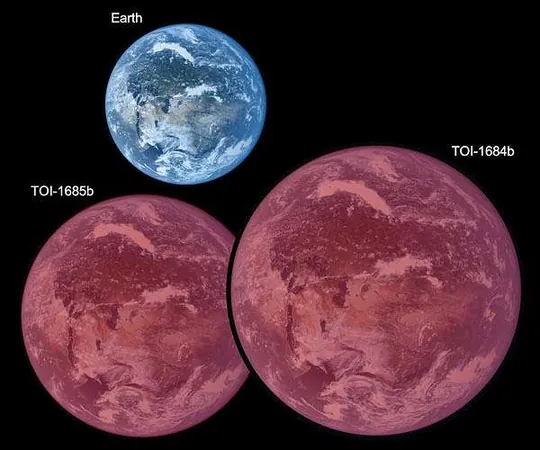
Breakthrough in Atmospheric Modeling Could Transform the Search for Life on Exoplanets and Early Earth
2024-11-20
Author: Wei Ling
Introduction
A revolutionary new modeling approach developed by Penn State scientists is set to enhance our understanding of the atmospheric conditions on early Earth and help astronomers in the hunt for habitable exoplanets. This advancement comes at a time when technological progress in observational astronomy promises to yield rich data on planets beyond our solar system.
Correlated-K Method and Its Significance
In a study published in the journal *JGR Atmospheres*, researchers utilized a statistical method known as correlated-k to significantly improve existing photochemical models that simulate the atmospheric chemistry of early Earth. These models traditionally use a one-dimensional (1D) framework that only examines the atmosphere along a single vertical column. However, this new correlated-k approach empowers scientists to better discern the composition of gases in the early atmosphere.
Findings from the Study
Jim Kasting, an esteemed geoscientist and co-author of the study, highlighted the significance of these models in searching for life beyond Earth. "One of the primary methods for identifying potential life in the universe is through the detection of biosignatures," he explained. "We rely on powerful telescopes to capture spectra of distant atmospheres, and our photochemical model is crucial for interpreting these spectra and identifying potential biosignatures that could indicate life."
Implications for Future Research
The implications of this research extend beyond understanding our planet’s own history. With upcoming observational missions planned for the next decade, such as NASA’s James Webb Space Telescope and the ESA's ARIEL mission, the availability of new data could dramatically shift the paradigm in our search for life-supporting planets.
The Role of Ozone and UV Radiation
The study delves into the details of ultraviolet (UV) radiation's critical role in ozone formation. When solar UV radiation interacts with molecular oxygen (O2), it can break these molecules apart, leading to the creation of free oxygen atoms that subsequently bond to form ozone (O3). This atmospheric ozone acts as a protective shield, filtering harmful radiation. However, accurately modeling this process has proven challenging due to the complex absorption features associated with specific UV wavelengths known as Schumann-Runge (SR) bands.
Limitations of Current Models
The researchers noted that while contemporary models function well for Earth's current oxygen-rich atmosphere, they often fall short when applied to the low-oxygen environments of early Earth or similar exoplanets. The existing Whole Atmosphere Community Climate Model, for example, effectively simulates UV absorption today but fails to account for scattering effects critical in low-oxygen atmospheres.
Advantages of the New Approach
The new correlated-k approach enhances the predictive power of photochemical models by accurately grouping solar energy wavelengths and correlating their absorption properties. This method is not only computationally efficient but also offers a more precise approximation of atmospheric interactions with solar radiation. As a result, scientists can expect more reliable data when analyzing the potential habitability of distant worlds.
Collaboration and Global Efforts
This groundbreaking collaboration brought together experts from various institutions, including the New Mexico Institute of Mining and Technology and the National University of Cordoba in Argentina, underscoring the global effort to unravel the mysteries of our atmosphere and the cosmos.
Conclusion
In conclusion, as research continues and new telescopes come online, this refined modeling technique stands poised to play a pivotal role in both comprehending our planet's atmospheric history and advancing our pursuit of extraterrestrial life. The universe is vast, and with these tools at our disposal, the search for life-supporting planets may be closer than ever before!




 Brasil (PT)
Brasil (PT)
 Canada (EN)
Canada (EN)
 Chile (ES)
Chile (ES)
 España (ES)
España (ES)
 France (FR)
France (FR)
 Hong Kong (EN)
Hong Kong (EN)
 Italia (IT)
Italia (IT)
 日本 (JA)
日本 (JA)
 Magyarország (HU)
Magyarország (HU)
 Norge (NO)
Norge (NO)
 Polska (PL)
Polska (PL)
 Schweiz (DE)
Schweiz (DE)
 Singapore (EN)
Singapore (EN)
 Sverige (SV)
Sverige (SV)
 Suomi (FI)
Suomi (FI)
 Türkiye (TR)
Türkiye (TR)